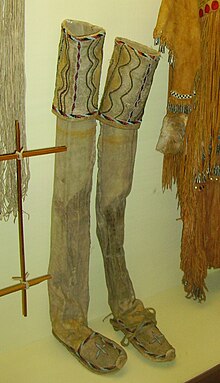leggings
Leggings or leggings (derived from the English leg "leg") are mostly skin-tight pants made of cotton , viscose , synthetic fibers or leather . Leggings are also called tight or tights designated (English tights derived from tight "eng").
history
Leggings came in various forms in North America, Asia, and Europe. They were worn by men and women for protection from the cold and thorns. Suede leggings were mostly worn by various indigenous tribes of North America. This Indian custom was adopted by French trappers , and the Mountain Men in the American Rocky Mountains later adapted this clothing.
Cowboys wore wide trousers made of suede, also called chaps , with no use for the buttocks. These protected the cowboys' trousers from wear and tear when riding. They also protected the rider from the thorns of the bushes and cacti, from snakebites or ticks. The suede used at the time was mostly dull and gray in appearance.
Contemporary use
The use of so-called gymnastic pants in sports emerged in the 20th century. In gymnastics , the cycling , bodybuilding , ballet , aerobics , etc. they proved to be practical, because they hardly affect the movement, keep warm the muscles and absorb sweat immediately and can deliver (depending on the material) to the outside. In sportswear, leggings are now often made from special functional materials based on Lycra or nylon .
In the 1980s, leggings became increasingly popular as casual wear and were combined with a wide variety of footwear. Shiny leggings made of lycra or elastane , often in bright colors, were popular. Leggings have been making a comeback in fashion since around 2006. They are often combined with skirts or hot pants, which can also be worn in winter thanks to the warming leggings. Following this trend, from 2008 skin-tight trousers (“ treggings ”) and leggings made of denim material were marketed as “ jeggings ”. In addition to Lycra, nylon and cotton, shiny or matt leather is also used as a material. Leather leggings require special care with leather care products and impregnation spray.
Executions
Contemporary leggings usually cover the legs completely up to the ankle, in addition to tight-fitting versions with flared legs are offered. Depending on the company / variant, leggings also have pockets. The waistband can have an elastic or drawstring. In countries like Russia or Korea, wool leggings are worn by women and men as an additional warming layer under their trousers in cold seasons.
Sports leggings
This type, also known as gymnastic pants , is cut from thickly knitted fabric panels and is therefore opaque.
Stocking leggings
Stocking leggings, like tights, are made of two seamless stocking tubes, but in 7/8 length and usually with a slight transparency of the material, which is why additional items of clothing are worn at least over the pelvis . The exception to this point is the more densely knitted "jeggings".
Seamless variants
There are also variants known as seamless for the aforementioned widespread cuts.
- Seamless L-hose. Here only the waistband is sewn on, the rest is knitted from one piece.
- Straight, mostly seamless hose. Here, the middle of the front and back is cut open to crotch height in order to sew the two strips of fabric that have been created into trouser legs. A gusset can also be used in the crotch area to compensate for stretching; so this cut is only seamless on the outer edges.
Variations of the cut
- Capri pants (the legs end at the calf)
- Cycling shorts (the legs end above the knee joint)
- Pantaloons
Katarina Witt in leggings with a bridge under a leotard
Wetlook leggings on a catwalk
Seamless mesh leggings with white cotton gusset turned inside out
Web links
Individual evidence
- ↑ See Online Etymology Dictionary legging
- ↑ See Duden online: Leggings , Leggins
- ↑ See Duden online: Tight
- ↑ Werner Arens, Hans-Martin Braun: The Indians of North America. History, culture, religion (= Beck series. 2330: CH Beck Wissen). Beck, Munich 2004, ISBN 978-3-406-50830-1 , p. 33.
- ↑ Factsheet North Carolina Indians (PDF), section Gifts from the Indians .





